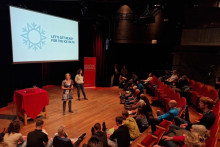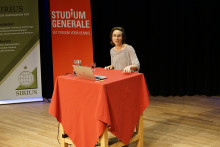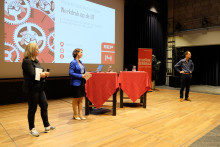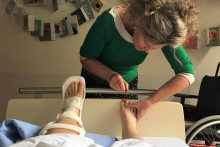De Boer, assistant professor at the ITC faculty, came across the Wim Hof method after the birth of her son, during a period when she started exhibiting symptoms of an autoimmune disease. De Boer struggled to accept her diagnosis, and the fact that she would have to spend a lifetime using medication. She started researching her disease and what she could do to improve her symptoms. ‘I kept thinking, Is it true that I cannot do anything? That’s when I came across the Wim Hof method.’
Heated discussion with doctor
‘Except for the Wim Hof method, I also started journaling and eating as healthy as possible in order to allow my body to heal’, she continues. ‘When I started to feel very good, I went back to my doctor, and I told him that I would like to stop my medication.’ However, her doctor did not agree with her decision. ‘Our discussion was very heated, he was telling me that I will die and that I was crazy because this method would never work’, explains De Boer. After De Boer was tested, her results were very good, and her doctor could not believe it. As she says: ‘We can do what science says we cannot.’
The Wim Hof method
The Wim Hof method is a popular wellbeing technique developed by the Dutch extreme athlete Wim Hof, also known as ‘the Iceman’. The method has three components: breathing exercises, cold exposure and meditation and dedication. The method is deemed controversial, especially following the death of an American teenager in August 2022. Scientific evidence supporting the method is relatively meagre.
Van der Werf, study advisor at the Mechanical Engineering programme, has a similar story. In 2015 she was diagnosed with hip arthritis, and as a marathon runner she was devastated. ‘I had to give up my running which I really loved, and I discovered the Wim Hof method during a workshop. I felt the energy of the method.’
She decided to follow a ten-week training. In the beginning she was mostly using a so-called cold-water technique. ‘I began swimming in the canal in front of my house in Amsterdam, and the feeling was amazing’, she says. Last year, Van der Werf became very ill from a bacterial infection in her abdominal cavity and she would have to consume antibiotics for up to 9 months, but as she says: ‘My diagnosis was during the summer so I could not commit to the cold water method, but that’s when I started to use the breathing exercises and I committed to them. After three months my infection was gone.’
‘We just put on a sweater’
Van der Werf further explained the mechanism behind one of the pillars of the Wim Hof Method, the cold-water exposure. ‘When our body gets cold, our brain gets a signal, and all of your vessels constrict in our arms and legs to preserve the heat in our core. Nowadays, we do not train our thermoregulation system anymore. Whenever we feel cold, we just put on sweater, and we do not allow our vessels to constrict and dilate, which is a really great workout.’
‘Cold exposure does not have to be extreme, you can either take a cold shower for thirty to ninety seconds, or you can take a cold bath for maximum two minutes’, says Van der Werf. ‘Committing to the cold exposure technique can be hard, but the more often I do it, it gets easier for me to remember the feeling afterwards’, adds De Boer. ‘We are used to this comfortable world, and choosing to do something uncomfortable is a skill’, she says, adding that benefits of cold exposure are increased energy levels, reduced inflammation and decreased stress levels among the numerous.
Controversies
Meditation can be used in both cold exposure and breathing exercises because it is important to stay focused and calm, explains De Boer. As for the controversies, concerning accidents and deaths of individuals trying these methods, De Boer believes that these exercises should be avoided by individuals suffering with epilepsy and other serious diseases. ‘If you want to try it, it is important to talk to your doctor or to a trained professional to know whether you can do these exercises and how to slowly start.’







